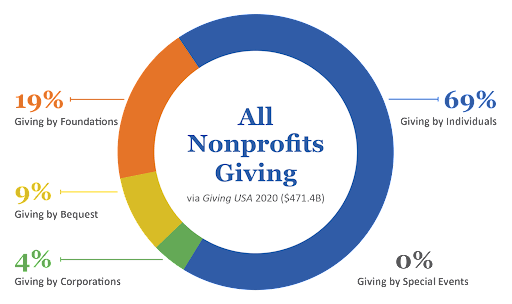Analyzing the Obstacles and Opportunities Faced by a Nonprofit Company in Achieving Its Goal and Objectives in Today's Society
In the current landscape, not-for-profit companies are navigating a complex selection of difficulties, such as fluctuating financing resources and enhanced competitors for contributor engagement. By checking out exactly how nonprofits can strategically adjust to these dynamics, we can uncover not just the methods they employ to get over barriers however also the untapped possibility that exists within their operational structures.
Present Landscape for Nonprofits
The current landscape for nonprofits is characterized by an intricate interplay of advancing financing designs, heightened competitors for benefactor focus, and raising needs for accountability and openness. Nonprofit companies are increasingly diversifying their earnings streams to include gives, individual contributions, corporate sponsorships, and social business campaigns. This shift shows a tactical feedback to conventional financing sources coming to be a lot more competitive and unforeseeable.
Moreover, the increase of electronic communication systems has transformed just how nonprofits engage with possible donors. Social network, crowdfunding, and on-line projects are currently vital devices for getting to wider target markets, yet they also heighten competitors among organizations competing for minimal resources. In this environment, nonprofits should improve their messaging to effectively catch the interest and commitment of fans.
Additionally, stakeholders are demanding higher openness concerning exactly how funds are allocated and the measurable effect of not-for-profit activities. This pattern demands that organizations take on robust responsibility actions, including thorough coverage and analysis structures, to show their performance. As a result, the not-for-profit field is browsing a landscape that calls for cutting-edge reasoning, calculated versatility, and a dedication to honest methods in order to prosper in the middle of these dynamic difficulties and chances.
Secret Difficulties Come Across
Browsing the not-for-profit field presents a myriad of challenges that can impede business performance and sustainability. One of the most pressing concerns is the reliance on irregular funding sources. Nonprofits commonly depend on grants, donations, and government assistance, which can rise and fall substantially, bring about financial instability and difficulties in lasting planning.

Personnel retention and volunteer engagement present further obstacles, as many nonprofits battle to offer competitive wages and benefits. The high turnover prices can disrupt business continuity and impact service delivery.
Moreover, adjusting to technological innovations and digital transformation stays a difficulty for many nonprofits. A lack of resources and expertise can avoid organizations from leveraging innovation effectively, thereby limiting their outreach and efficiency.
Eventually, these difficulties need nonprofits to utilize calculated preparation and cutting-edge approaches to maintain their objective and make sure sustainability in an intricate landscape. nonprofit agency.
Arising Opportunities
Just how can nonprofits harness emerging chances to boost their influence? In today's swiftly evolving landscape, nonprofits have the opportunity to leverage technical innovations, changing social characteristics, and boosted public recognition to enhance their goals.
In addition, cooperation with services and various other fields is coming to be a lot more widespread, offering nonprofits with accessibility to resources, competence, and ingenious services. Partnerships can magnify initiatives, drive neighborhood engagement, and create lasting influences. Additionally, the growing focus on business social duty supplies nonprofits chances to align with companies that focus on social effect, gaining financial support and shared objectives.
The boosting emphasis on data-driven decision-making enables nonprofits to much better evaluate their programs and end results, boosting responsibility and performance. By embracing these emerging possibilities, nonprofits can not just fortify their operational capacities but also broaden their impact in addressing pressing social concerns, ultimately driving meaningful modification in their areas.
Techniques for Adaptation
Adapting to a regularly transforming setting is important for nonprofits aiming to sustain their effect and efficiency. visit this site To browse the intricacies of modern-day culture, nonprofits must implement tactical techniques that boost their durability and responsiveness.
One trick approach entails leveraging modern technology to streamline operations and expand outreach. By making use of electronic systems, find out this here nonprofits can enhance communication with stakeholders, enhance fundraising efforts, and boost recognition of their mission. Furthermore, embracing data-driven decision-making techniques allows organizations to assess their programs' efficiency and adjust strategies based on empirical proof.
Partnership with other organizations-- both for-profit and nonprofit-- can promote resource sharing and technology. nonprofit agency. Collaborations can lead to common experience, moneying possibilities, and broadened networks, ultimately intensifying the collective impact
In addition, cultivating a society of versatility within the organization is vital. Training team to accept change and urging creative analytic can empower groups to respond properly to emerging obstacles.
Situation Studies and Success Stories
Successful adaptation approaches in the nonprofit field can typically be illustrated with engaging situation studies and success tales. One notable instance is the "Feeding America" network, which transformed its procedures during the COVID-19 pandemic. By leveraging modern technology and neighborhood collaborations, the organization scaled its food circulation efforts to fulfill the unmatched demand, offering countless family members who faced food instability.
An additional impactful situation is the "Boys & Girls Clubs of America," which adjusted its programs to a digital format throughout lockdowns. By introducing on the internet mentorship and engaging tasks, they preserved connections with youth throughout the country, ensuring ongoing assistance and advancement in spite of the difficulties presented by social distancing.
Similarly, the "Globe Wild Animals Fund" has effectively incorporated community-based conservation methods, empowering neighborhood populaces to participate in wildlife protection initiatives. This method not only cultivates community possession but check out here additionally enhances environmental sustainability.
These case research studies highlight exactly how nonprofits are not just dealing with instant difficulties yet are also developing lasting solutions that straighten with their goals. By sharing such success stories, companies can motivate others to adapt and innovate, eventually driving favorable adjustment within their areas.

Verdict
To conclude, not-for-profit firms today browse a complex landscape characterized by economic instability, competitors, and labor force obstacles. Nonetheless, the possibility for development and development remains significant. By accepting digital outreach, fostering partnerships, and carrying out data-driven methods, these organizations can improve their operational effectiveness and better line up with neighborhood requirements. Eventually, dealing with both difficulties and chances will be important for nonprofits to satisfy their goals and attain long lasting influence in society.
In the current landscape, nonprofit firms are navigating a complicated array of difficulties, such as fluctuating financing sources and increased competitors for contributor involvement. The nonprofit sector is navigating a landscape that requires ingenious reasoning, tactical flexibility, and a commitment to honest techniques in order to flourish amidst these vibrant obstacles and opportunities.
Browsing the not-for-profit market provides a myriad of difficulties that can hinder organizational performance and sustainability.In final thought, nonprofit firms today navigate a complex landscape defined by financial instability, competitors, and labor force challenges. Eventually, addressing both challenges and chances will certainly be essential for nonprofits to accomplish their missions and attain long-term influence in culture.